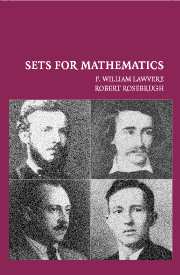Book contents
- Frontmatter
- Contents
- Foreword
- Contributors to Sets for Mathematics
- 1 Abstract Sets and Mappings
- 2 Sums, Monomorphisms, and Parts
- 3 Finite Inverse Limits
- 4 Colimits, Epimorphisms, and the Axiom of Choice
- 5 Mapping Sets and Exponentials
- 6 Summary of the Axioms and an Example of Variable Sets
- 7 Consequences and Uses of Exponentials
- 8 More on Power Sets
- 9 Introduction to Variable Sets
- 10 Models of Additional Variation
- Appendixes
- Bibliography
- Index
Foreword
Published online by Cambridge University Press: 06 July 2010
- Frontmatter
- Contents
- Foreword
- Contributors to Sets for Mathematics
- 1 Abstract Sets and Mappings
- 2 Sums, Monomorphisms, and Parts
- 3 Finite Inverse Limits
- 4 Colimits, Epimorphisms, and the Axiom of Choice
- 5 Mapping Sets and Exponentials
- 6 Summary of the Axioms and an Example of Variable Sets
- 7 Consequences and Uses of Exponentials
- 8 More on Power Sets
- 9 Introduction to Variable Sets
- 10 Models of Additional Variation
- Appendixes
- Bibliography
- Index
Summary
Why Sets for Mathematics?
This book is for students who are beginning the study of advanced mathematical subjects such as algebra, geometry, analysis, or combinatorics. A useful foundation for these subjects will be achieved by openly bringing out and studying what they have in common.
A significant part of what is common to all these subjects was made explicit 100 years ago by Richard Dedekind and Georg Cantor, and another significant part 50 years ago by Samuel Eilenberg and Saunders Mac Lane. The resulting idea of categories of sets is the main content of this book. It is worth the effort to study this idea because it provides a unified guide to approaching constructions and problems in the science of space and quantity.
More specifically, it has become standard practice to represent an object of mathematical interest (for example a surface in three-dimensional space) as a “structure.” This representation is possible by means of the following two steps:
(1) First we deplete the object of nearly all content. We could think of an idealized computer memory bank that has been erased, leaving only the pure locations (that could be filled with any new data that are relevant). The bag of pure points resulting from this process was called by Cantor a Kardinalzahl, but we will usually refer to it as an abstract set.
(2) Then, just as computers can be wired up in specific ways, suitable specific mappings between these structureless sets will constitute a structure that reflects the complicated content of a mathematical object. For example, the midpoint operation in Euclidean geometry is represented as a mapping whose “value” at any pair of points is a special third point.
- Type
- Chapter
- Information
- Sets for Mathematics , pp. ix - xiiPublisher: Cambridge University PressPrint publication year: 2003

